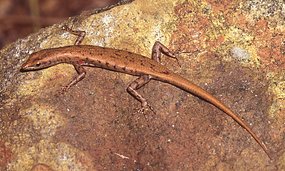
January 30, 2008

Cryptoblepharus daedalos, one of 13 new skink species discovered by Northern Territory scientists. (Dr. Paul Horner)
New research by the Territory and South Australian Museums has uncovered a number of new species of snake-eyed skinks.
Of the 17 new species discovered in Australia and Papua New Guinea, nine were found in the Northern Territory of Australia (also called “Oz” by local media).
Many of the creatures, whose scientific name is Cryptoblepharus, are unique to the Territory — and some are very rare.
Dr. Horner, a curator at the Museum and Art Gallery of the NT, said it was very exciting to come across a new species that was strikingly different.
“It’s not easy to do these days,” he said.
“One of the gaudy ones, which I’ve called the spangled snake-eyed skink, is only known from Mount Borradaile in Arnhem Land, just north of Oenpelli,” Horner noted.
He said a spangled snake-eyed skink found only on Mount Borradaile in Arnhem Land was his most recent and “prettiest” discovery.

Dr Paul Horner with a Swanson’s snake-eyed skink.
“I was confident straight away that it was a new species,” he said.
“It was so distinctly different I knew it was new — usually it takes a lot of lab work.”
Snake-eyed skinks can be found in suburban gardens, Dr Horner said.
Skinks are often found on tree trunks, fences and walls in suburban gardens and parks and look like lizards with short legs.
Dr. Paul Horner, from the Museum and Art Gallery of the Northern Territory, says many of the 13 new species discovered are unique to the Territory and only live in specialised areas.
“There’s also another one which is only known from some offshore islands off (the) Cobourg (Peninsula) from the New Year Island, Oxley Islands and North Goulbourn Island,” Horner said.
Dr. Horner says the small reptiles are an important part of the eco-system.
“Sometimes you can got to a tree and you might see half a dozen or even up to 30 animals up there. So extrapolating up from that you can imagine they are a very important food resource for lots of birds and other reptiles and all sorts of things would be feeding on them.
“Because they are insectivorous, they are eating an awful lot of insects themselves.”
Sources: “Thirteen new skinks discovered in NT,” Australian Broadcasting Corporation, January 30, 2008. “Lizards lounge all over NT,” Northern Territory News, January 27, 2008.
About Loren Coleman
Loren Coleman is one of the world’s leading cryptozoologists, some say “the” leading living cryptozoologist. Certainly, he is acknowledged as the current living American researcher and writer who has most popularized cryptozoology in the late 20th and early 21st centuries.
Starting his fieldwork and investigations in 1960, after traveling and trekking extensively in pursuit of cryptozoological mysteries, Coleman began writing to share his experiences in 1969. An honorary member of Ivan T. Sanderson’s Society for the Investigation of the Unexplained in the 1970s, Coleman has been bestowed with similar honorary memberships of the North Idaho College Cryptozoology Club in 1983, and in subsequent years, that of the British Columbia Scientific Cryptozoology Club, CryptoSafari International, and other international organizations. He was also a Life Member and Benefactor of the International Society of Cryptozoology (now-defunct).
Loren Coleman’s daily blog, as a member of the Cryptomundo Team, served as an ongoing avenue of communication for the ever-growing body of cryptozoo news from 2005 through 2013. He returned as an infrequent contributor beginning Halloween week of 2015.
Coleman is the founder in 2003, and current director of the International Cryptozoology Museum in Portland, Maine.
Filed under Breaking News, Cryptotourism, CryptoZoo News, Cryptozoologists, Cryptozoology, New Species